Do you happen to own a 1951 Wheat penny? Or maybe you’re thinking about picking one up for your collection?
Either way, understanding its value is essential—and we’ve got everything you need to know right here.
We’ll break down how much a 1951 penny can be worth, explain what makes certain coins more valuable than others, and explore some of the fascinating error coins that collectors are always on the lookout for.
So if you’re curious about the hidden potential of this humble one-cent coin, let’s dive in!
1951 Wheat Penny Value Overview
| Mint Mark | MS60 | MS63 | MS65 | MS67 |
|---|---|---|---|---|
| 1951 (No Mint Mark) – Red | $4 | $10 | $26 | $1,300 |
| 1951-D – Red | $2 | $8 | $20 | $225 |
| 1951-S – Red | $3 | $8 | $22 | $325 |
1951 Proof Wheat Penny Values
| Grade | Red & Brown | Red | Cameo |
|---|---|---|---|
| PR60 | $26 | $30 | $35 |
| PR6 | $38 | $38 | $90 |
| PR65 | $60 | $90 | $250 |
| PR68 | – | $1,850 | $12,500 |
💡 Remember: The color (Brown, Red-Brown, or Red), mint mark, and overall condition of the coin all have a big impact on value. Special varieties like Cameo and Deep Cameo proof coins can command huge premiums!
History of the 1951 Wheat Penny
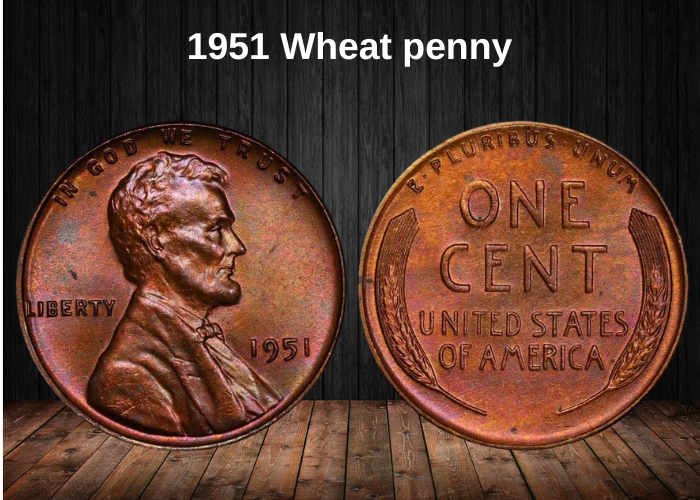
The 1951 Wheat penny is also often called a Lincoln cent, thanks to the image on the front—or obverse—featuring President Abraham Lincoln.
The nickname “Wheat penny” comes from the reverse design, which displays two stylized stalks of wheat curving along the sides. This design was featured on Lincoln cents from their debut in 1909 until 1958.
The Lincoln cent was first introduced to celebrate the 100th anniversary of Lincoln’s birth. In 1959, to mark 150 years since his birth, the reverse design was changed to show the Lincoln Memorial in Washington, D.C.
This coin was a milestone in American numismatics—it was the first U.S. coin to feature a real historical figure. Prior to this, it was believed that placing actual people on coins was too reminiscent of royal traditions.
Despite changes to the reverse over the years, the Lincoln cent remains in production today, making it one of the longest-running and most iconic coin series in U.S. history.
Features of the 1951 Wheat Penny
The Obverse of the 1951 Wheat Penny
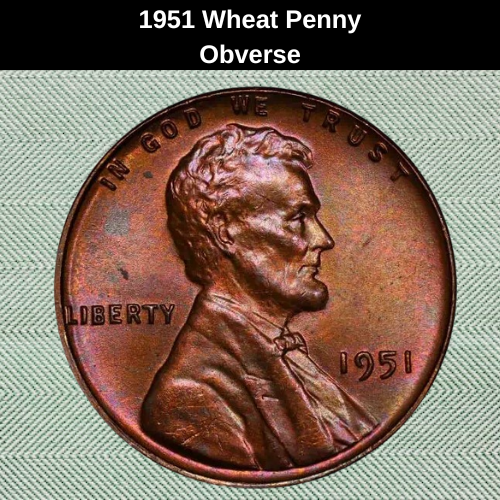
The 1951 Wheat penny’s obverse features a right-facing profile of President Abraham Lincoln. This iconic image was created by Victor David Brenner, an artist chosen—most likely with influence from President Theodore Roosevelt, who was a strong supporter of honoring Lincoln on a coin and had previously sat for Brenner.
When the Wheat penny was first issued in 1909, Brenner’s initials appeared prominently on the reverse. However, critics thought they were too noticeable and resembled a personal advertisement. The controversy led to a temporary halt in production, and the initials were removed.
It wasn’t until 1918 that Brenner’s initials were quietly returned, this time on the obverse, just at the base of Lincoln’s shoulder. On the 1951 penny, you’ll find them there—subtle, but present.
The rest of the design includes the phrase “IN GOD WE TRUST” arching over Lincoln’s head, “LIBERTY” on the left, and the minting year to the lower right. If your coin has no mint mark, it was minted in Philadelphia. A “D” indicates Denver, and an “S” means it was struck in San Francisco—both found just below the date.
The Reverse of the 1951 Wheat Penny
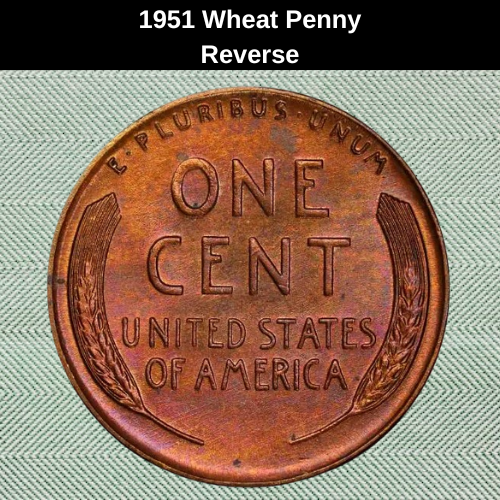
The Wheat penny gets its popular nickname from the reverse design, which features two stylized ears of wheat curving along the coin’s sides. Like the obverse, this artwork was created by Victor David Brenner.
Interestingly, the wheat wasn’t Brenner’s original concept. His first design included a tree branch, but Mint officials thought it looked too similar to contemporary French coinage. As a result, he was asked to revise it—leading to the familiar wheat stalks we see today.
These curved ears of wheat frame the central elements of the coin. At the center, the denomination “ONE CENT” is boldly displayed. Just above it, following the coin’s top curve, is the Latin motto “E PLURIBUS UNUM”, meaning “From many, one”, a nod to the union of the states that formed the United States.
Beneath the denomination, the inscription “UNITED STATES OF AMERICA” appears, neatly placed across two horizontal lines.
Other Features of the 1951 Wheat Penny
Just like other Wheat pennies, those minted in 1951 have a diameter of 19 millimeters and weigh 3.11 grams. If you check the coin’s edge, you’ll notice it’s plain, without any reeding or pattern.
These coins are composed of 95% copper, which affects their color over time. A well-preserved coin will typically have a bright red hue, while exposure to air and handling can cause the surface to oxidize, turning it brown.
When it comes to value, color plays a major role. All else being equal, red coins are the most desirable, followed by red-brown, and then brown examples, which are the most common and least valuable.
Color grading for copper coins follows a strict standard:
- A coin is graded “Red” (RD) if 95% or more of its surface retains the original red mint luster.
- If 95% or more of the coin has turned brown, it’s graded “Brown” (BN).
- Coins that fall somewhere in between are categorized as “Red-Brown” (RB).
1951 Penny Grading Scale
To accurately determine the value of your 1951 Wheat penny, it’s important to understand its grade—a reflection of its condition. The following scale is commonly used by collectors and grading services:
| Grade Number | Grade Description |
|---|---|
| 1 | Basal State-1 |
| 2 | Fair |
| 3 | Very Fair |
| 4–6 | Good (G) |
| 7–10 | Very Good (VG) |
| 12, 15 | Fine (F) |
| 20, 30 | Very Fine (VF) |
| 40 | Extremely Fine (EF/XF) |
| 50 | About Uncirculated (AU) |
| 60 | Mint State (MS 60) |
| 65 | Mint State (MS 65) |
| 70 | Perfect Mint State (MS 70) |
💡 Tip: For coins you suspect to be rare or valuable, it’s best to have them graded by a certified professional. Grading helps assess wear, surface quality, and even small imperfections, all of which influence the coin’s final market valu
1951 Wheat Penny Value Guides
1951 No Mint Mark Wheat Penny Value
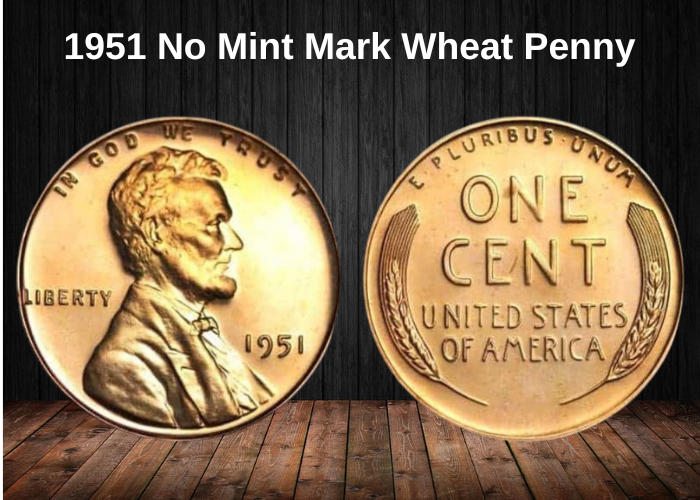
Even when in mint condition (graded MS60 and higher), brown or red-brown 1951 pennies aren’t typically very expensive. However, red pennies in the highest grades can be much more valuable.
According to independent grading company PCGS, a red 1951 Philadelphia penny is worth:
- $4 at MS60,
- $10 or more at MS63,
- and $26 at MS65, which is the minimum grade required to be considered a “gem.”
But the truly exceptional coins are worth far more.
The PCGS has only graded 60 pennies at MS67, each valued at $1,300. The absolute top-tier coins, with an MS67+ grade, are even rarer—just six have been certified, with a value of around $9,000 per coin.
1951 D Wheat Penny Value
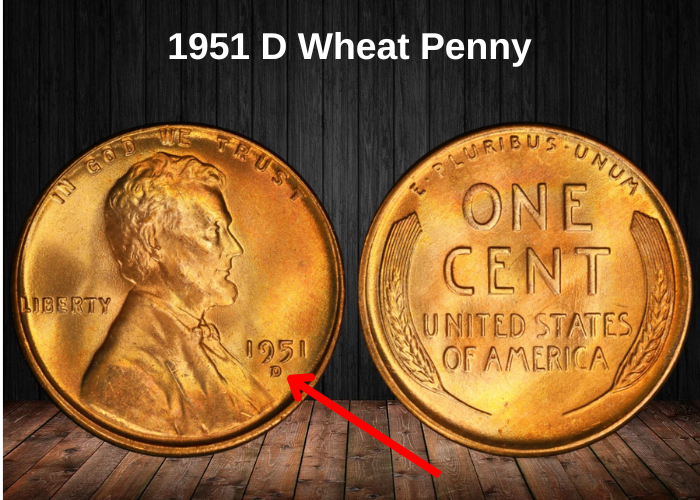
In 1951, the Denver Mint struck an astonishing 625 million pennies. Today, the PCGS estimates that around 62 million brown pennies remain across all grades.
The survival rate for red and brown pennies is notably lower, at about 8,400 examples, while red pennies also share a similar figure.
As with their Philadelphia counterparts, the abundance of circulated coins means they typically have a value close to face value, unless they feature a unique error.
For red 1951 D pennies, their value ranges as follows:
- $2 at MS60,
- $20 at MS65,
- $225 at MS67.
The highest graded examples are two coins certified at MS68, each valued at a remarkable $9,000.
1951 S Wheat Penny Value
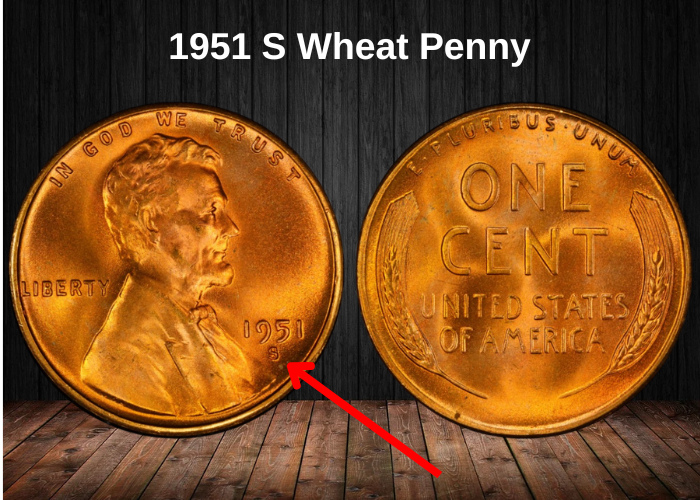
The San Francisco Mint produced a slightly smaller number of Wheat pennies in 1951, with a total of just over 136 million coins. While the mintage was lower compared to other Mint facilities, around 14 million coins are still in circulation, meaning the “S” mint mark doesn’t necessarily indicate rarity.
As with the Philadelphia and Denver coins, circulated 1951 S pennies are typically worth only their face value. For red mint state coins, those graded MS60 can usually be purchased for just a couple of dollars.
For gem-quality coins, values start around $22 at MS65, increasing to $32 at MS66 and $65 at MS66+.
Coins graded MS67 and above are rarer, and their prices reflect this. The PCGS currently values a red 1951 S penny at $325. For those graded MS67+, the value rises to $1,650.
Additionally, two coins have been certified at MS68, with PCGS valuing them at $10,000 each, although no public sales have been reported for these specific examples.
1951 (P) Proof Wheat Penny Value

In 1951, in addition to the standard business strike coins, the Philadelphia Mint also produced proof coins specifically intended for collectors. These coins were made using specially prepared dies and polished planchets, making them distinct from the regular coins used in circulation.
Only 57,500 proof coins were struck, and they can be classified into four categories based on their appearance, in rising order of desirability:
- Red and Brown
- Red
- Cameo
- Deep Cameo
Cameo proofs are coins with a notable contrast between reflective, flat surfaces and frosted raised designs. If the contrast is particularly sharp, the coin is designated as a deep cameo.
Proof coins are never intended for circulation, so their condition usually starts at PR60. Here are the general values for coins at that grade:
- Red and Brown Proof: $26
- Red Proof: $32
- Cameo Proof: $35
For gem examples, the values are higher:
- Red and Brown Gem: $60
- Red Gem: $90
- Cameo Gem: $250
The finest 1951 proof pennies ever certified are graded PR68, and these have significantly higher values:
- Red PR68: $1,850
- Cameo PR68: $12,500
The deep cameo coins from this mintage are scarcer and only appear in PR66, PR66+, and PR67 grades. At the lower end, a deep cameo might cost around $4,500. However, the most exceptional PR67 deep cameo coins can fetch as much as $40,000.
Rare 1951 Wheat Penny Errors List
1951 (P) No Mint Mark Wheat Penny, Double Die Obverse

Double die errors occur during the die manufacturing process, where the die is struck more than once with the hub to transfer the coin design. If the die shifts slightly during this process, it can cause doubling of some elements of the design. This results in coins with lines that appear twice, which is the hallmark of a double die error.
In 1951, one of the obverse dies used at the Philadelphia Mint exhibited this error, causing double lines to appear on certain parts of the design, particularly the letters in the word “LIBERTY”. The letters B, E, R, T, and Y are where the doubling is most noticeable, but it may be difficult to spot without magnification. A loupe or microscope is typically necessary to see the error clearly.
Here are the estimated values for 1951 Philadelphia double die pennies based on their condition:
- Brown coins:
- XF45: $25
- MS60: $30
- MS65: $45
- Red and brown coins:
- MS63: $50
- MS65: $125
- Red coins:
- MS63: $60
- MS65: $200
These values can vary depending on the degree of doubling and the overall condition of the coin.
1951 (P) No Mint Mark Proof Penny, Double Die Obverse
The double die error also affected proof pennies in 1951, which is quite rare considering the meticulous process involved in crafting proof coins. The error occurs similarly to business strike coins, with doubling visible on certain parts of the design, notably the letters in “LIBERTY”.
Values for 1951 proof pennies with this double die error are as follows:
- Lower uncirculated grades:
- PR60 red: ~$37
- PR62 red: ~$50
- PR64 red: ~$100
- Cameo with the error: Starts around ~$55 at PR60
- Higher-quality proof coins:
- PR67 red: ~$450
- Cameos:
- PR65+: ~$850
- PR66: ~$1,800
- PR67+ examples: Valued at $14,250 each
No deep cameos with the double die error have been discovered yet, but the value of the cameo specimens increases significantly with higher grades.
Where to sell your penny?
Now that you know the value of your penny, you might be wondering where to sell it. Don’t worry: here’s a guide to some of the best online platforms where you can easily sell your coins, along with their advantages and disadvantages.
Discover the best platforms for selling coins online (pros and cons).
FAQ about the 1951 Wheat Penny
1. Why is the 1951 Wheat Penny important in U.S. coinage history?
The 1951 Wheat Penny is historically significant because it marks the penultimate year of the Wheat reverse design, which had been in circulation since 1909. The following year, in 1952, the U.S. Mint introduced the Lincoln Memorial reverse design. The 1951 penny is notable as one of the last coins in the Wheat series, and its relatively high mintage means it is one of the last widely circulated coins before the design change.
2. What is the metal composition of the 1951 Wheat Penny?
The 1951 Wheat Penny is composed of:
- 95% copper
- 5% zinc
This was the standard composition used in U.S. pennies from 1909 to 1942 and then again from 1944 to 1958. The 1951 penny still follows this traditional metal composition, which was used for all Wheat pennies before the U.S. Mint transitioned to a new alloy in the 1960s.
3. How many 1951 Wheat Pennies were minted?
The 1951 Wheat Penny had a large mintage:
- Philadelphia (no mintmark): 1,063,030,000
- Denver (D): 175,035,000
- San Francisco (S): 58,620,000
With a total mintage of over 1.29 billion pennies, the 1951 Wheat Penny is one of the more common coins in the Wheat series. As a result, most 1951 pennies in circulated condition are relatively affordable.
4. What is the value of a 1951 Wheat Penny today?
The value of a 1951 Wheat Penny depends largely on its condition:
- Circulated coins: Typically worth around $0.05 to $0.25.
- Uncirculated coins: Those in MS-63 or MS-64 grade can be worth $1 to $10.
- High-grade coins (MS-65 or higher) can be worth $15 to $30, with MS-66 coins or better fetching higher prices, potentially going for $40 or more.
Despite its large mintage, coins in mint condition or those with unique errors can still fetch a premium.
5. Are there any notable error varieties in the 1951 Wheat Penny?
Yes, the 1951 Wheat Penny does have a few error varieties that collectors find interesting:
- Double Die Obverse (DDO): Some 1951 pennies show a doubled die on the obverse, especially on the “LIBERTY” and “IN GOD WE TRUST” inscriptions. These doubled coins are highly sought after by collectors.
- Off-center Strikes: As with other coins, off-center errors may occur, resulting in coins with misaligned designs or part of the coin’s features being missing.
- Die Cracks: The 1951 penny may also show die cracks or cud marks—small areas where the die that strikes the coin is damaged or eroded. These features make the coin more collectible for error enthusiasts.
Error coins tend to have higher values than non-error coins, especially when found in high-quality condition.
6. How does the 1951 Wheat Penny compare to other years in the Wheat series?
- 1950 Wheat Penny: The 1950 penny is the last year of the Wheat reverse design, and although the 1951 penny is similar in appearance and composition, it is part of the final years of the Wheat series before the design change to the Lincoln Memorial reverse.
- 1952 Wheat Penny: The 1952 penny marks the beginning of the Lincoln Memorial reverse, which is a significant departure from the Wheat design. The 1951 penny is notable because it represents one of the last opportunities to collect a Wheat penny before the design was phased out.
The 1951 penny holds a position as a transition coin, marking the end of the Wheat reverse and the beginning of the Lincoln Memorial reverse era.
7. How can I identify a high-grade 1951 Wheat Penny?
To identify a high-grade 1951 Wheat Penny, collectors should look for the following characteristics:
- Sharp details: The wheat stalks, Lincoln’s portrait, and inscriptions (“LIBERTY” and “IN GOD WE TRUST”) should be clear and sharp, with no signs of wear or fading.
- Minimal wear: A high-grade coin will show no wear on the high points like Lincoln’s face or the wheat heads. An uncirculated coin will have these features in full, crisp detail.
- Clean, smooth surfaces: There should be no surface scratches, marks, or tarnish. A high-grade coin will have smooth surfaces free from imperfections.
- Luster: The coin should have a shiny luster, with no scratches or abrasions that diminish its brightness. Uncirculated coins should reflect light brightly and uniformly across the surface.
Coins graded MS-65 or higher are considered high-grade and are more valuable to collectors, especially if they exhibit outstanding luster and sharp detail.



















































